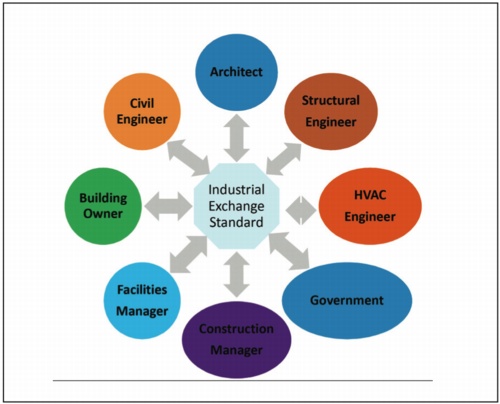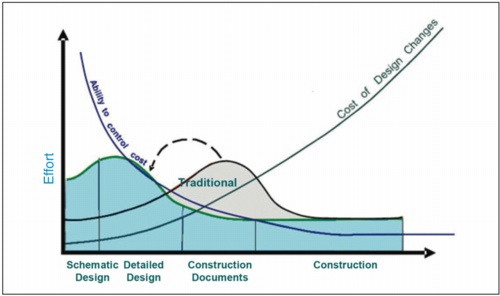On the road to BIM

In the drive to reduce construction costs and deliver better projects by making possible total collaboration throughout the life of a project, building information modelling (BIM) is attracting increasing attention.
(Here is the main text of this article. For the printed version with illustrations in full context, you can download the pdf file using the link at the end of this item.) According to a couple of recent industry surveys, most readers will not have heard of Building Information Modelling (BIM) and are unlikely to be able to define it or understand its implications for the future of the construction industry.
Make no mistake about it, however. The implications are massive. They are here and now, with BIM already being used to a greater or lesser extent by various organisations. The Government is sitting up and taking notice, as evidenced in the recently published report ‘Low carbon construction’ by the Innovation & Growth Team headed by the Government’s chief construction adviser Paul Morrell.
It is little over a year since Paul Morrell’s appointment as chief construction adviser, during which time he has consistently argued the need to drive down costs. On BIM, he says, ‘I am convinced that this is the way to unlock new ways of working that will reduce cost and add long-term value to the development and management of built assets in the public sector, but the move needs to be made on a basis that is secure, that works for Government clients and those who deliver services to them.’
The latest IGT report seeks to add pace by recommending that ‘Government should mandate the use of Building Information Modelling for central Government projects with a value greater than £50 million’.
Against that background, a recent CIBSE event on BIM was well timed to raise awareness of BIM and the undoubted opportunities it will bring.
Event chairman Terry Wyatt set the scene by saying, ‘According to Paul Morrell, there have been 63 quarters of rapid and massive construction activity, and now it has come to an end. The clever companies are those that have invested in R&D. The great phrase is “more for less”, but not by dropping quality and standard, but by cutting out the waste and boosting efficiency, which is where BIM comes in. Those that work on BIM now will be those who are best equipped when work returns.’
There is a number of definitions of BIM, as summarised in the panel. All are based on high-powered information technology to provide an all-embracing model from which the various parties involved in all stages of a construction project and the subsequent operation of the resulting building can extract the information they need directly rather than create their own documentation.
The grand vision of fully implemented BIM came from Mike Beaven, BIM leader with Arup. He described BIM as ‘a process of real-time collaboration in a virtual environment using 3D models’.
To demonstrate the enormous potential of BIM, Mike Beaven highlighted the five stages of a project that it should be involved in to deliver that potential.
• Inception — to improve optioneering, visualisation and early-stage simulation.
• Design — to increase cost certainty, collaboration, simulation and incorporate changes at a lower cost than at the construction stage.
• Documentation — to provide clearer communication, better understanding and enriched deliverables.
• Construction — to speed up this stage of a project, reduce clashes and waste, and improve safety.
• Operation — to enable the performance of the actual building to be monitored, and improve asset management and maintenance.
That final stage achieves one of the holy grails of facilities managers — an as-built model. If a BIM model were to be used by a building operator, information could go full circle back to the very early stages of a project for the benefit of future projects.
Mike Beaven indicated how the industry needs to prepare itself and what the future will hold: ‘We need new skills, that include modelling and simulation. We have to work in a 3D environment.’ And then the carrot: ‘The BIM model can bring teams back together.’
The current state of play was explained by Dr Stephen Hamil, head of BIM with National Building Specification. The NBS 2010 BIM survey revealed that awareness and use of BIM was very low at just 13% of respondents. A further 45% were just aware of BIM and 43% were not aware of BIM at all. Dr Hamil commented, ‘We find these figures quite alarming, especially with Government pushing BIM.’
Even among those indicating awareness of BIM, take-up is still very low, with just 10% of respondents currently using BIM for most or all projects, but rising rapidly to 63% in five years’ time.
Taking into account respondents that have used BIM for a minority of projects takes the current user base to 31%, rising in five years’ time to 86%.
Generally speaking, those organisations that have adopted BIM are pleased that they did. 58% reported that they had successfully adopted BIM, to a greater or lesser extent, and only 4% indicated that they would rather not have adopted it.
The perceived benefits of the exponents of BIM are showing up in practice, but not to the extent that might be hoped for. Perhaps that is because implementation needs to be better thought out and put into practice. The NBS survey revealed that for organisations using it, BIM increased speed of delivery for 51% of respondents. 61% reported cost efficiencies and 53% an increase in profitability. There were larger improvements in the co-ordination of construction documents (81%), productivity due to easy retrieval of information (84%) and visualisation (53%).
An important lesson is that adopting BIM required changes in workflow, practices and procedures — as reported by 88% of respondents.
A potential springboard for the future more widespread of BIM is the existing use of CAD, and Dr Hamil indicated how CAD capabilities are evolving into BIM. Examples included the 77% of respondents who generate 3D visualisations for at least some of their projects, of which 11% do it all the time. Bills of quantity are produced from CAD models by 7% of respondents for all or most projects and occasionally by a further 8%.
Engineers love schematics, and one presented by Paul Coates of John McCall Architects in Liverpool draws together the full extent of the contribution that BIM can make to interoperability (Fig. 1). He has been involved in the implementation of BIM for a couple of years and stresses that there is a lot more to BIM than the widely held perception by architects of BIM as a 3D model. His summary is: ‘BIM enables data to be combined rather than looked at in an isolated way.’
Paul Coates’ experience is that the initial challenge is the transition from 2D CAD to 3D BIM without losing ground. Benefits then come thick and fast, such as the automatic generation of drawings taking a third of the time previously needed, with consistent and clear output.

One important expectation of BIM is its ability to reduce costs — a theme explored by Dr Sarah Graham of Integrated Environmental Solutions. She compared the timelines of the conventional and integrated design processes from schematic design, through detailed design, construction documents and construction (Fig. 2).
Her key points were that the ability to control costs is much greater early in the timeline than later on and that the cost of design changes escalates rapidly as the project progresses. Putting more effort into the project at its earlier stages would enable the cost of design changes to be reduced considerably. For example avoiding having to put right a clash which is discovered on site could immediately save about £500.
Although elements of BIM are being implemented by architects, consultants and contractors, it remains to persuade clients — an issue taken up by Anne King of BSRIA and buildignSMART. The ideas she presented came from a poll among delegates to a conference organised by BSRIA late last year.
• 48% said it is important that BIM is required in submissions to Building Regulations and other statutory duties.
• 78% said it is important that the Government mandates BIM to help clients understand that it is worthwhile.
• 83% said it is important that BIM delivers electronic O&M manuals.
• 87% said it is important that we have more good UK case studies.
So what might the future look like? A good summary came from Dr Stephen Hamil, head of BIM with National Building Specification.
His first point is that BIM is not a single CAD program but the integration of many software programs and data from many data providers to provide information.
BIM is actually here and now, with many practices taking small steps. That said, most of the market is far from ready, but does accept the inevitability of a BIM future.
But we aren’t there yet, and software companies and data providers have to accelerate getting BIM to happen under the hood.
Ultimately, however, many things will not change. Engineers will still engineer, architects will still design, and contractors will still construct. BIM is not a threat, but an opportunity.
Some definitions of building information modelling
BIM is best thought of as a digital representation of physical and functional characteristics of a facility...and a shared knowledge resource for information about a facility forming a reliable basis for decisions during its lifecycle; defined as existing from earliest conception to demolition.
National Institution of Building Sciences.
Building Information Modelling is a new approach to being able to describe and display the information required for the design, construction and operation of constructed facilities. It is able to bring together the different threads of information used in construction into a single operating environment, thus reducing, and often eliminating, the need for many different types of paper document currently in use.
buildingSMART
Building Information Modelling is the process of generating and managing building data during its life cycle. Typically it uses 3-dimensional, real-time, dynamic building modelling software to increase productivity in building design and construction. The process produces the BIM, which encompasses building geometry, spatial relationships, geographic information, and quantities and properties of building components.
Wikipedia
A Building Information Model is a rich information model consisting of potentially multiple data sources, elements of which can be shared across all stakeholders and be maintained across the life of the building from inception to recycling (cradle to cradle)
The information model can include contract and specification properties, personnel, programming, quantities, cost, spaces and geometry.
NBS definition.








